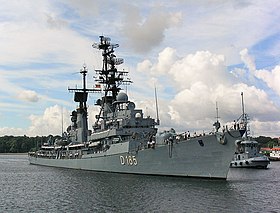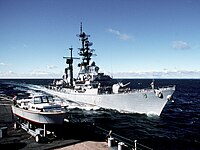Class 103 / 103A / 103B
|
|
|
|---|---|
 Destroyer Lütjens (Class 103B) |
|
| Overview | |
| Type | destroyer |
| units | 3 |
| Shipyard | |
| Keel laying | 1966-1967 |
| Launch | 1967-1969 |
| Commissioning | 1969-1970 |
| Decommissioning | 1999-2003 |
| Whereabouts | see units |
| Technical specifications | |
| displacement |
4162 t |
| length |
134.48 m |
| width |
14.35 m |
| Draft |
6.1 m |
| crew |
334 |
| drive |
2 steam turbines with 25,750 kW each from 4 high-pressure boilers |
| speed |
35 kn |
| Range |
4500 nm at 20 kn |
| Armament |
|
| radar |
|
| sonar |
|
The class 103 / 103A / 103B was the development line of a class of guided missile destroyers of the German Navy . It consisted of three units. The ships were built from 1966 to 1970 in the USA for the Federal Republic of Germany as modified ships of the American Charles F. Adams class Mod. 14 (Tartar-Guided Missile Destroyers SCB 155), which at that time had been in the Service in the US Navy. After the first ship of the class , the Lütjens , the class is unofficially referred to as the Lütjens class .
history
Planning and construction
The ships were on 11 May 1964 by the federal government , where the government of the United States in order. On April 1, 1965, the Bath Iron Works received the official order for the destroyers DDG 28 to DDG 30. The first ship was laid down on March 1, 1966 as DDG 28 , christened Lütjens on August 11, 1967 and launched. She was put into service on March 23, 1969. The Mölders entered service on September 20, 1969, and the Rommel on May 2, 1970. The ships were supposed to replace the old class 119 destroyers ( Fletcher class ). They were the first ships in the German Navy to be armed with guided missiles and equipped with a command and control system ( SATIR ). In contrast to the American sister ships, the three German destroyers had different radio equipment and control electronics, a different mast and chimney arrangement ( Mack ) and a different placement of the sonar dome below the ship. In addition, the crew quarters had been improved. The units were assigned to Class 103.
designation
The ships were named after highly decorated soldiers from the armed forces of the Second World War : Günther Lütjens , Erwin Rommel and Werner Mölders .
period of service
The class 103 / A / B ships formed the 1st destroyer squadron in Kiel. The ships regularly took part in the exercises of NATO's permanent task forces in the Atlantic ( STANAVFORLANT ) and in the Mediterranean ( STANAVFORMED ). Starting with the drum 1998, the destroyer of the Class 103 / A / B were then asked to 2003 out of service and the frigates of the class 124 is replaced.
Modifications
In the 1970s, the 127 mm turrets Mod.7 were exchanged for Mod.10 guns on all three ships, the boiler system was converted to light heating oil, the Tartar fire control system received a digital computer and the Tartar rockets and their launchers became exchanged for the lighter standard missile system. The class name is now class 103A.
In the 1980s a deckhouse was built to accommodate parts of the Mk 86 artillery fire control system, which replaced the previous Mk 68. The antenna of the AN / SPG-60 aerial target radar was placed on this deckhouse . At the same time, the front mast was converted by adding a platform with a radome for the AN / SPQ-9 marine target radar , and other radar systems were modified. In addition, the units received two RIM-116 RAM starters for short-range Defense, SRBOC - chaff launcher for radar illusion of anti-ship missiles , and two 20-mm Oerlikon guns . The anti -submarine armament and combat command system have been adjusted. With these modernizations, the destroyers belonged to Class 103B.
A renewed modernization of the weapon system was not carried out, not least against the background of the enormous personnel requirements and the high maintenance costs for the steam system and the associated costs.
technology
drive
Each ship had two high pressure, hot steam turbines in two turbine rooms. The turbines developed an output of approx. 25,750 kW (35,000 PS ) each . The required steam was generated from four high pressure kettles developing 1271 psi . The boilers were divided into two boiler rooms. The turbines acted via two shafts on two four-bladed fixed propellers with a diameter of 4.12 m . In the turbine rooms there were also the electric generators, which, like the fresh water generators, were also operated with steam.
weapons
The armament was as follows over time:
Configuration as class 103:
- 2 × 127 mm / 54 Mk 42 Mod 7 gun turrets
- 1 × FK starter (single starter) of the Tartar weapon system RIM 24 B Mk 13
- 1 × ASROC starter MK16 Mod. 4
- 2 × three torpedo tube sets UTR 324 mm Mk 32 Mod 7
Configuration as class 103A and 103B:
- 2 × 127 mm / 54 Mk 42 Mod 10 gun turrets
- 1 × single FK Starter Mk 13 Mod 1 for Standard Missile and Harpoon
- 1 × ASROC starter MK16 Mod. 4
- 2 × three torpedo tube sets UTR 324 mm Mk 32 Mod 7
From the mid-1990s onwards:
- 2 × RIM-116 Rolling Airframe Missile Starter MK 49 with 21 missiles each
- 2 × SRBOC - chaff launcher MK36
- 2 × on-board guns 20 mm
- optional two aviator fists and two machine guns
Fire control systems and sensors
Various fire control systems and sensors were installed while the units were in service .
- GFCS MK-86 Mod.8 Artillery fire control system
- MFCS MK-74 Mod.6 fire control system with 2 AN / SPG-51 against air targets
- AN / SPG-51C FK guide radar
- AN / SPG-60 radar illuminator for fire control system Mk 86
- AN / SPQ-9A track-while-search radar for Mk 86
- DSQS-21B active / passive bug sonar
- AN / SPS-67 medium range marine surveillance radar
- AN / SPS-40 2D mid-range air surveillance and early warning radar
- AN / SPS-52 3D long range air surveillance radar
- Raypath RAY RP 1225 navigation radar
- AN / WRN-6 GPS
- URD-4 UHF visual direction finder, exchanged for SFP 7200.1 in 1996
- FL 1800 EW system
- AN / URN-20 TACAN system, Tactical Air Navigation
Organization on board
In order to carry out the various tasks on board, the officers, NCOs and men were divided into four main sections according to their assignment. Each main section (HA) thus contained certain areas of responsibility and was subordinate to a main section head .
The main section 100 (ship operations) was the most staffed and included, among other things, the deck service (sailors' guests , also called " 11er ", " Decksziegen " or "Little Picassos"), the nautical service (navigation guests), the telecommunications and the signals. The main section was led by the SEO (ship operations officer).
The main section 200 (ship technology) was entrusted with all tasks related to propulsion and energy supply. The main section head was the STO (ship technical officer), who is to be equated with the LI in civil shipping. Members of this section (also called " cellar children ", " stokers " or " black feet ") were constantly on board to maintain the energy supply. They belonged to the application series 41 (steam technology), 42 (engine technology), 43 (electrical engineering) and 44 (ship operating technology).
The main section 300 (ship electronics and weapons) was responsible for the operation and maintenance of the various telecommunication, computer, radar and weapon systems. These tasks were not performed in shift work (except for exercises), which is why members of this section were also called " hobbies " or " day laborers ". The exception to this was the operator of the central computer system. To do this, however, they always had to take part in “ all man ” tasks (e.g. taking over provisions).
The main section 400 (supply / central services) comprised the areas of personnel management, cash / accounting, spare parts management, catering and canteen as well as the medical area. The smuts (cooks) were responsible for preparing five meals a day (breakfast, second breakfast, lunch, dinner and middle watchman for the night shift). In the ship's hospital, health complaints were treated by a ship's doctor. A dentist was also embarked for longer voyages. Personnel matters were clarified via the ship's watchmaker's office. The supply office and the supply cataloging office (VKS) were responsible for the provision of spare parts.
units
| Lü tjens - class | ||||||||||
|---|---|---|---|---|---|---|---|---|---|---|
| Surname | Identifier | Radio call sign | Construction number |
keel interpretation |
Stack run |
Indienst- position |
Außerdienst- position |
Whereabouts | photo | |
| until 11/30/81 | from 01.12.81 | |||||||||
| Lütjens | D 185 | DBYB | DRAE | 351 (DDG 28) | 03/01/1966 | 08/11/1967 | March 22, 1969 | 12/18/2003 | Canceled in Turkey in 2012 |

|
| Mölders | D 186 | DBYC | DRAF | 352 (DDG 29) | 04/12/1966 | 04/13/1968 | 09/20/1969 | 05/28/2003 | Museum ship in the Naval Museum Wilhelmshaven |

|
| Rommel | D 187 | DBYD | DRAG | 353 (DDG 30) | 08/22/1967 | 02/01/1969 | 05/02/1970 | 06/30/1999 | Canceled in Turkey in 2004 |

|
References
literature
- Gerhard Koop / Siegfried Breyer: The ships, vehicles and planes of the German Navy 1956 until today . Bernard & Graefe Verlag, Munich 1996, ISBN 3-7637-5950-6 .
- Wolfgang Harnack: The destroyer flotilla of the German Navy from 1958 until today . Koehlers Verlagsgesellschaft, Hamburg 2001, ISBN 3-7822-0816-1
See also
Web links
- Destroyer of the "Lütjens" class (103B) on marine.de. Retrieved December 6, 2013 .
Individual evidence
- ↑ Jürgen Rhades (Ed.): Yearbook of the German Navy . Carl Schünemann Verlag, Bremen 1972, p. 138 (8th episode).


